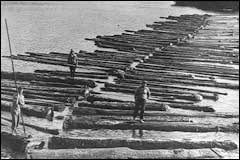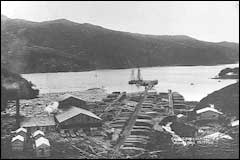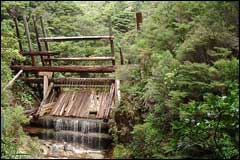Kauri - a Natural resource
 Logs were tied together and floated across to Auckland 100 km away |
|
 The mill at Whangaparapara processed kauri logs from Great Barrier Island and also from the mainland |
Maori knew the value of the giant kauri that grew on Great Barrier Island. The trunks were valued for canoes as they were the same girth for many metres. Kauri gum and dust was used for fire lighting and as a fuel for torches. Old gum was burnt and the ash used as a tattoo pigment. Occasionally the gum was burnt at kumara plots as an insect repellent.
The Europeans also found the timber to be strong and sturdy. In early pioneering days it was used for shipbuilding, housing and cart making. The grain of the timber was striking and often kauri timber was used for church pews or counters in shops and post offices.
Ship building began with the construction of the William and Anne in 1796. Many others were built including the Stirlingshire, the Tryphena and the Rory O'More. Pohutukawa was often used in the construction. Smith's shipyard operated in Smith's Bay from 1873.
Whangaparapara once had the largest timber mill in the Southern Hemisphere. An estimated 60 - 90 million feet of logs from GBI and nearby islands was milled in the years between 1880 and 1941. The forest was cleared and often the under growth was burnt to prevent accidental fires. The only original stands of kauri are on the summit of Mt Hirakimata.
|
A feature of the kauri logging on Great Barrier was the use of dams to flush the logs down the steep hillsides to the sea. Some were built as late as the 1920's. Once the water was released, the logs were carried downstream to the ocean and then floated in huge rafts to Auckland. Tramlines often transported logs that were milled on the island. Today many of the walking tracks use these tramline cuttings.
The Kauri Timber Company sawmill was used 1909-1914 at Whangaparapara. It processed logs not only from Great Barrier but others that were rafted to the island from Northland and the Coromandel.
Once the logging had ceased the Forest service planted 150,000 kauri seedlings between 1976 and 1987.
